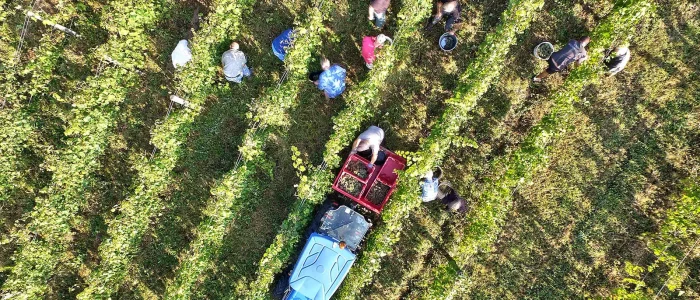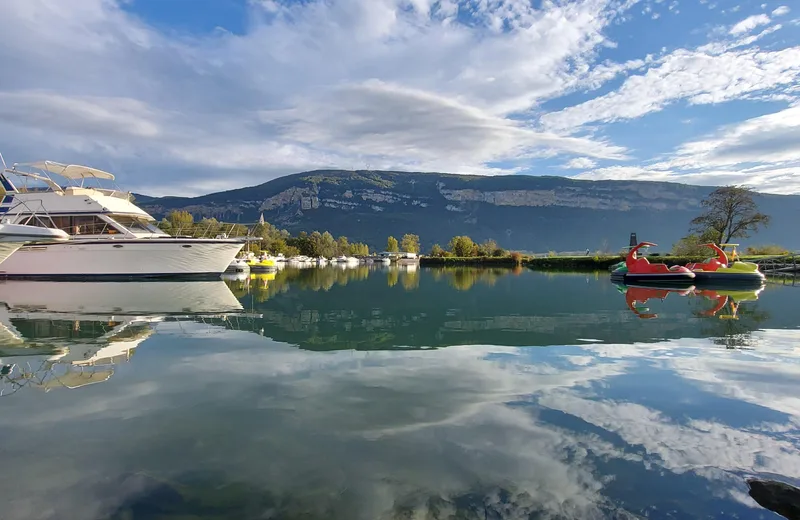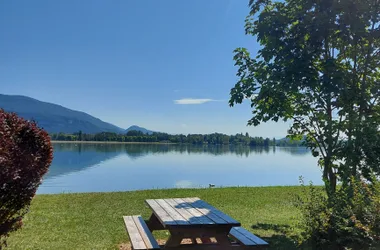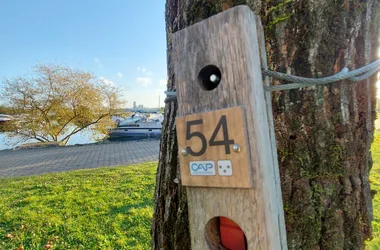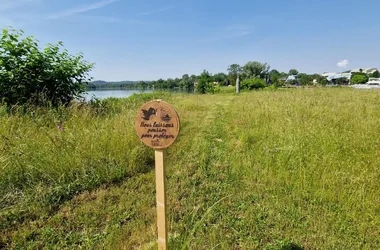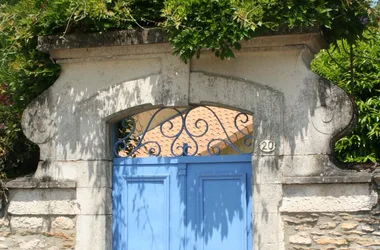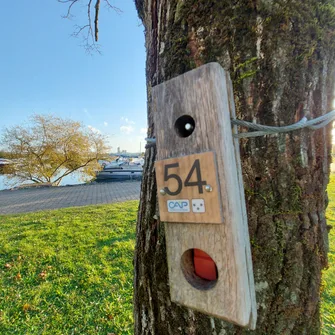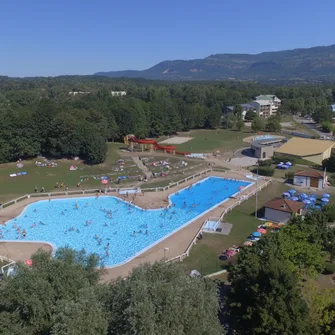Welcome to Montalieu-Vercieu, a village to the north-east of the Balcons du Dauphiné bordered by the Rhône, home to the Vallée Bleue leisure center as well as the Ninon Vallin performance hall.
1. Montalieu-Vercieu and its heritage
– The Rhône and the Villebois stone.
The village developed around the extraction of stone from Villebois and the Rhône. Over the centuries, men have tamed this river and carried out developments (dykes and a little further on, a hydroelectric production plant) allowing the development of essential river economic activity and helping to shape the landscape.
River transport, still very active in the 19th century, made it possible to transport various goods including the famous Villebois stone.
This very hard limestone, sometimes called “choin de Villebois”, exploited since Gallo-Roman times, developed particularly at the end of the 17th century with the construction of the Hôtel-Dieu in Lyon.
From this period until the 19th century, Villebois stone was widely used to build quays, bridges and Haussmann buildings in Lyon. It is also found abroad, such as in New York, in the basement of the Empire State Building.
It was the Rhône that made it possible to develop the trade in stone, which was transported to Lyon or Vienna, using large barges, dikes before the railway and then trucks then took over.
The sailor stripes, still visible today, recall the extraction of this hard and compact stone.
In 1817, the manufacture of cement began with Louis Vicat, recognized as the inventor of artificial cement. Today the cement plant still exists and belongs to the Vicat group.
It was the emergence of cement that marked the end of the golden age of Villebois stone. However, the industry still exists today, with a dozen companies and a training center.
A stone and cement museum, closed today, recalled the history of these two industries.
– The church of Montalieu: built in 1833 with local stone, this church, dedicated to Saint-Louis, is distinguished by its old stained glass windows, notably that of the choir representing the King of France.
The facade of the church includes a central portal topped by a triangular pediment decorated with a statue of Saint-Louis.
– The church of Vercieu: the first known mention dates from 1823.
– Vernacular heritage: 19th century oven in Vercieu, wash houses and fountains.
-Oratory of the Virgin
– The Vercieu Patrimoine Vivant association aims to restore the old church of Vercieu and more broadly to preserve, rehabilitate and enhance the heritage of Montalieu-Vercieu through cultural projects.
– The railway: due to the growing trade linked to stone, two stations were built in Montalieu.
A railway line was opened in 1875 between Lagnieu and Montalieu, it is connected to the Lyon-Geneva line managed by the Paris-Lyon-Mediterranean company (PLM). It crossed the Rhône between Villebois and Montalieu on a bridge destroyed on June 19, 1940 by the French army. Then a second track completed the network in 1881, managed by the Chemin de Fer de l'Est Lyonnais (CFEL) which operated the Montalieu station until 1952.
2. Montalieu-Vercieu, nature and leisure side
– The Vallée Bleue leisure center offers a multitude of activities such as mountain biking, aquapark, a treetop adventure course, water pedaling, jetskiing, fishing, mini-golf, rail cycling, etc.
Take advantage of its green spaces and picnic areas to take a break.
– The Vallée Bleue orienteering courses: 1 children's course (blue color, easy level, 2 km; 40 minutes, 8 markers) and 1 adult course (red color, medium level, 2,7 km, duration 1h15, 14 tags).
– The Haut-Rhône railway, reminiscent of the old Montalieu PLM station, near the Vallée Bleue.
– The “Au fil du Rhône” thematic trail: a marked route for
discover the history of the workers of the Rhône River, ideal for hikers and/or cyclists (D+ 180 m; 16,2 km loop).
– ViaRhôna
3. Montalieu-Vercieu and culture
– The Ninon Vallin space: a cultural and leisure center which offers a very diverse program each year.
It takes its name from the famous singer Ninon Vallin, a native of Montalieu-Vercieu with a remarkable destiny. She sang for an audience for the first time at just 10 years old, then was admitted to the Lyon Conservatory at 17. This lyrical singer made her debut at the Opéra-comique in Paris in 1912 and quickly became an international star, performing around the world, notably in Buenos Aires, thanks to her mastery of the French, Italian and Spanish languages. In 1925, she received the distinction of Knight of the Legion of Honor, the highest French honorary decoration. During the Second World War, her career was at a standstill, she lived on her property near Lyon, before resuming her concerts in Paris and then abroad. In 1953, she created the music conservatory of Montevideo (Uruguay) where she taught singing. She retired from the stage in 1971, then continued to teach singing at the Lyon Conservatory until the end of her life in 1961.
– Le Festi' Planches: this annual festival highlights local amateur talents, ranging from theater to dance, including music and singing.
– The Rhône and the Villebois stone.
The village developed around the extraction of stone from Villebois and the Rhône. Over the centuries, men have tamed this river and carried out developments (dykes and a little further on, a hydroelectric production plant) allowing the development of essential river economic activity and helping to shape the landscape.
River transport, still very active in the 19th century, made it possible to transport various goods including the famous Villebois stone.
This very hard limestone, sometimes called “choin de Villebois”, exploited since Gallo-Roman times, developed particularly at the end of the 17th century with the construction of the Hôtel-Dieu in Lyon.
From this period until the 19th century, Villebois stone was widely used to build quays, bridges and Haussmann buildings in Lyon. It is also found abroad, such as in New York, in the basement of the Empire State Building.
It was the Rhône that made it possible to develop the trade in stone, which was transported to Lyon or Vienna, using large barges, dikes before the railway and then trucks then took over.
The sailor stripes, still visible today, recall the extraction of this hard and compact stone.
In 1817, the manufacture of cement began with Louis Vicat, recognized as the inventor of artificial cement. Today the cement plant still exists and belongs to the Vicat group.
It was the emergence of cement that marked the end of the golden age of Villebois stone. However, the industry still exists today, with a dozen companies and a training center.
A stone and cement museum, closed today, recalled the history of these two industries.
– The church of Montalieu: built in 1833 with local stone, this church, dedicated to Saint-Louis, is distinguished by its old stained glass windows, notably that of the choir representing the King of France.
The facade of the church includes a central portal topped by a triangular pediment decorated with a statue of Saint-Louis.
– The church of Vercieu: the first known mention dates from 1823.
– Vernacular heritage: 19th century oven in Vercieu, wash houses and fountains.
-Oratory of the Virgin
– The Vercieu Patrimoine Vivant association aims to restore the old church of Vercieu and more broadly to preserve, rehabilitate and enhance the heritage of Montalieu-Vercieu through cultural projects.
– The railway: due to the growing trade linked to stone, two stations were built in Montalieu.
A railway line was opened in 1875 between Lagnieu and Montalieu, it is connected to the Lyon-Geneva line managed by the Paris-Lyon-Mediterranean company (PLM). It crossed the Rhône between Villebois and Montalieu on a bridge destroyed on June 19, 1940 by the French army. Then a second track completed the network in 1881, managed by the Chemin de Fer de l'Est Lyonnais (CFEL) which operated the Montalieu station until 1952.
2. Montalieu-Vercieu, nature and leisure side
– The Vallée Bleue leisure center offers a multitude of activities such as mountain biking, aquapark, a treetop adventure course, water pedaling, jetskiing, fishing, mini-golf, rail cycling, etc.
Take advantage of its green spaces and picnic areas to take a break.
– The Vallée Bleue orienteering courses: 1 children's course (blue color, easy level, 2 km; 40 minutes, 8 markers) and 1 adult course (red color, medium level, 2,7 km, duration 1h15, 14 tags).
– The Haut-Rhône railway, reminiscent of the old Montalieu PLM station, near the Vallée Bleue.
– The “Au fil du Rhône” thematic trail: a marked route for
discover the history of the workers of the Rhône River, ideal for hikers and/or cyclists (D+ 180 m; 16,2 km loop).
– ViaRhôna
3. Montalieu-Vercieu and culture
– The Ninon Vallin space: a cultural and leisure center which offers a very diverse program each year.
It takes its name from the famous singer Ninon Vallin, a native of Montalieu-Vercieu with a remarkable destiny. She sang for an audience for the first time at just 10 years old, then was admitted to the Lyon Conservatory at 17. This lyrical singer made her debut at the Opéra-comique in Paris in 1912 and quickly became an international star, performing around the world, notably in Buenos Aires, thanks to her mastery of the French, Italian and Spanish languages. In 1925, she received the distinction of Knight of the Legion of Honor, the highest French honorary decoration. During the Second World War, her career was at a standstill, she lived on her property near Lyon, before resuming her concerts in Paris and then abroad. In 1953, she created the music conservatory of Montevideo (Uruguay) where she taught singing. She retired from the stage in 1971, then continued to teach singing at the Lyon Conservatory until the end of her life in 1961.
– Le Festi' Planches: this annual festival highlights local amateur talents, ranging from theater to dance, including music and singing.
Themes:
Visit
Individual visit services
- Unguided individual tours permanently
Opening
| Opening hours from January 01 to December 31, 2024 | |
|---|---|
| Monday | Open |
| Tuesday | Open |
| Wednesday | Open |
| Thursday | Open |
| Friday | Open |
| Saturday | Open |
| Sunday | Open |
Prices
Free access.
Services
Equipments
Activities on site
- Orientation course
Linked offers
On the spot…
